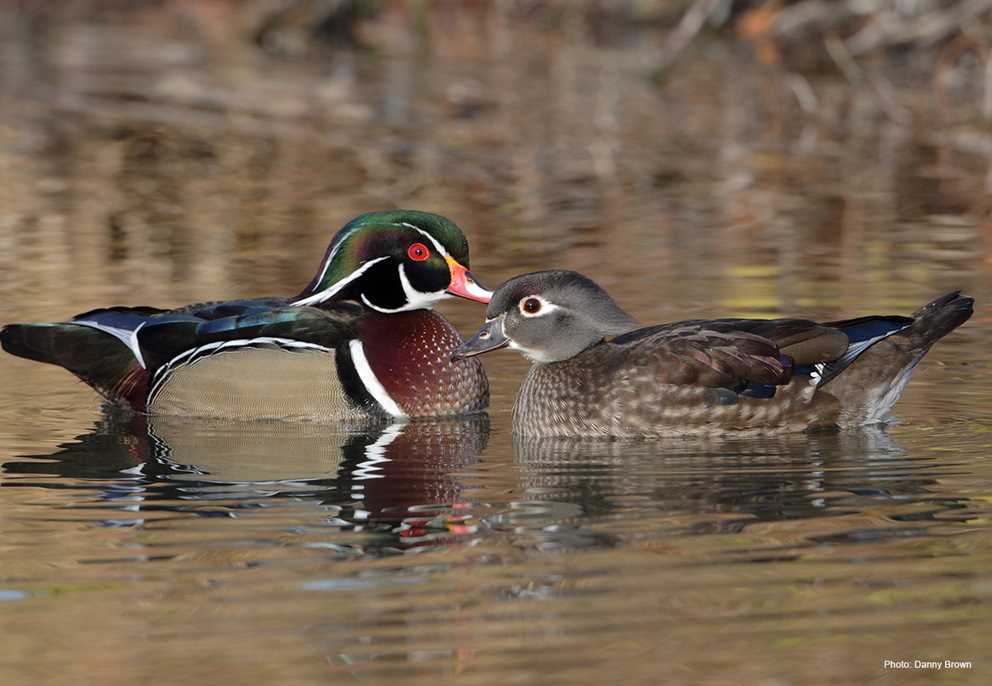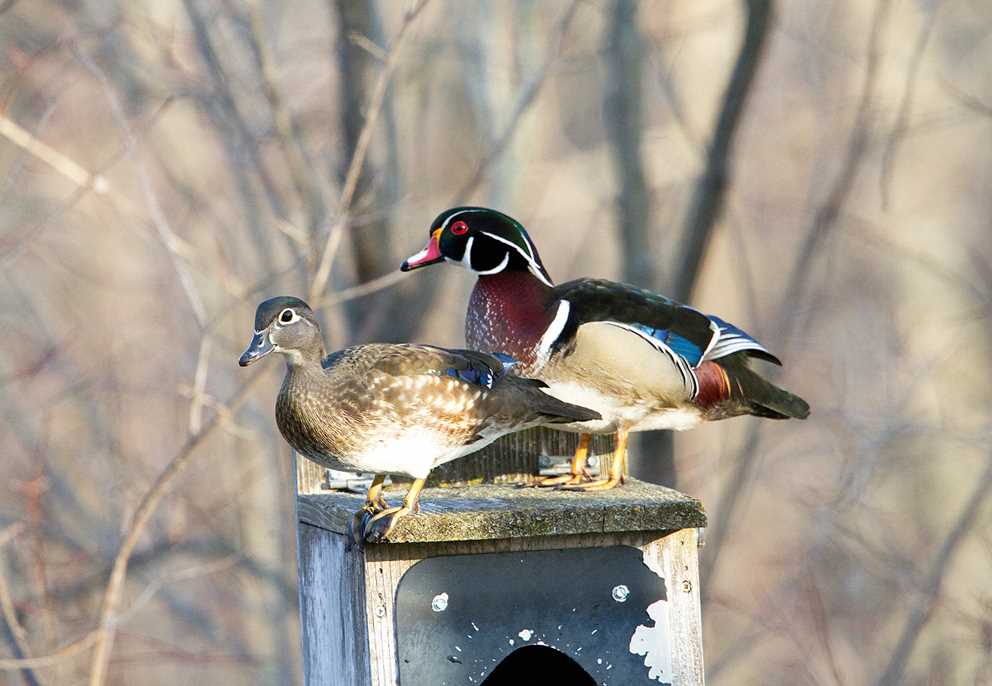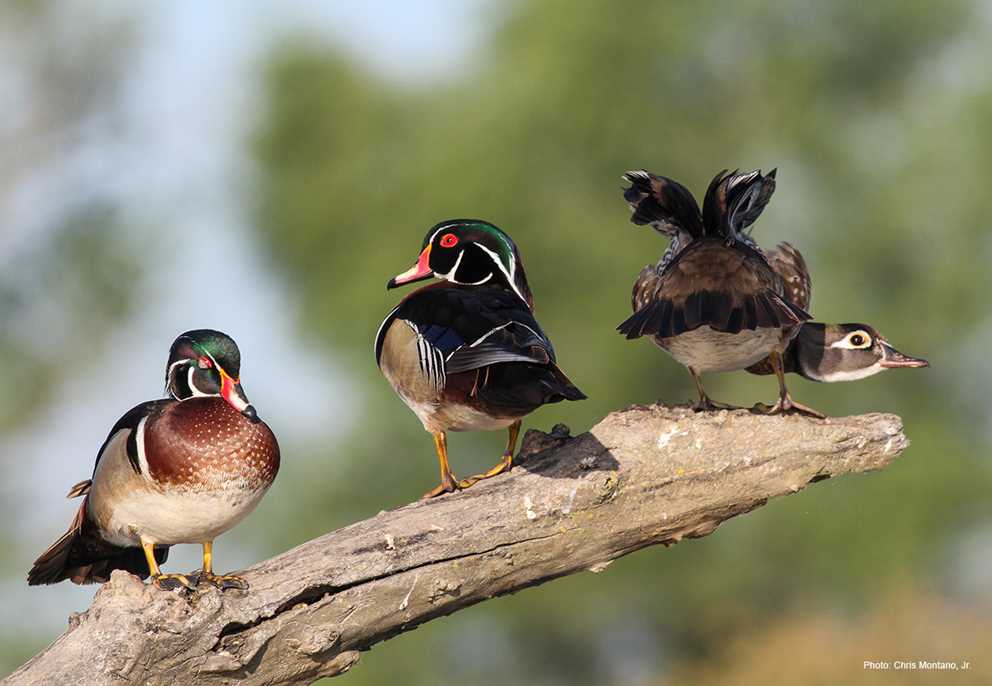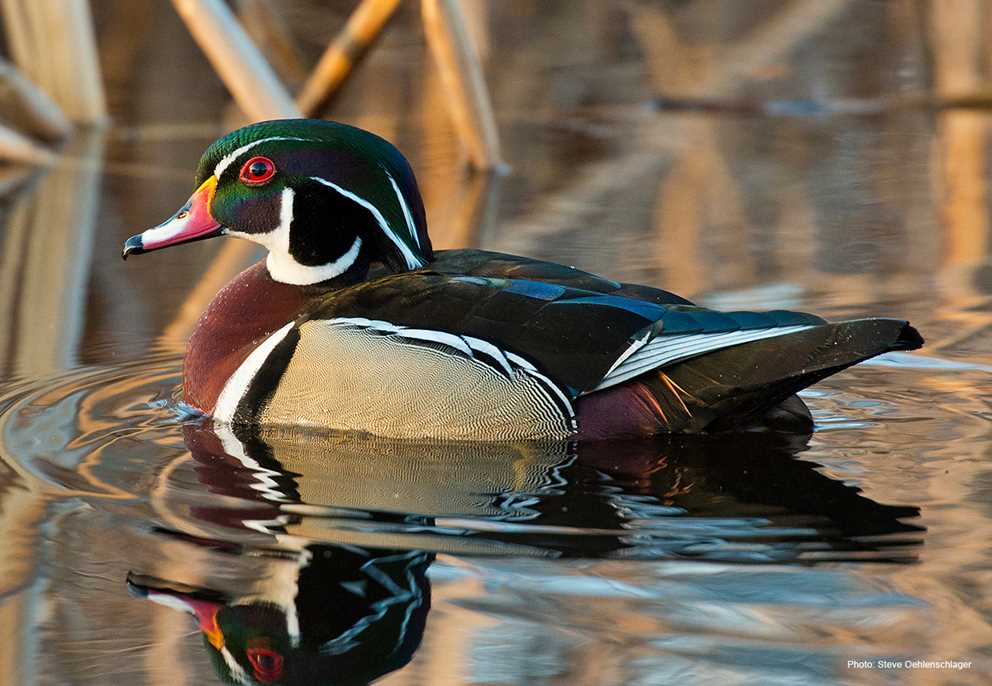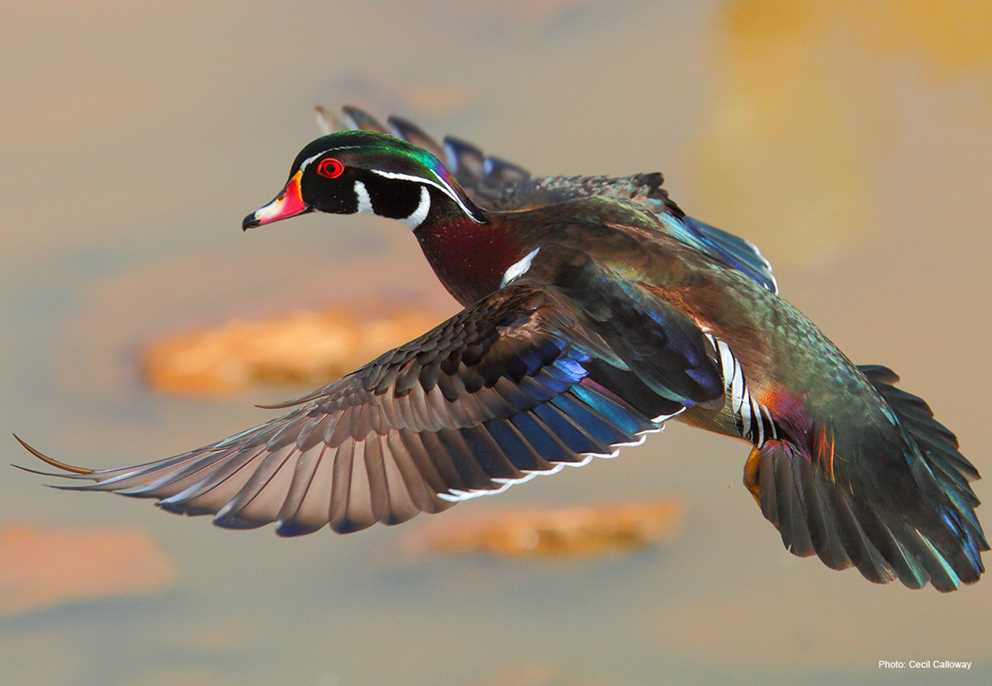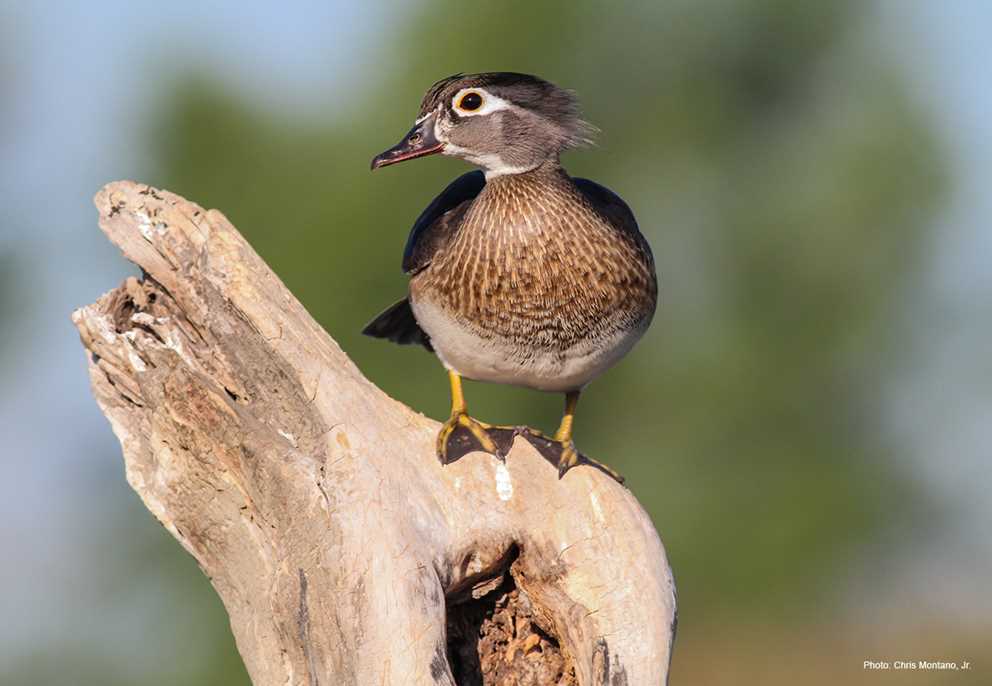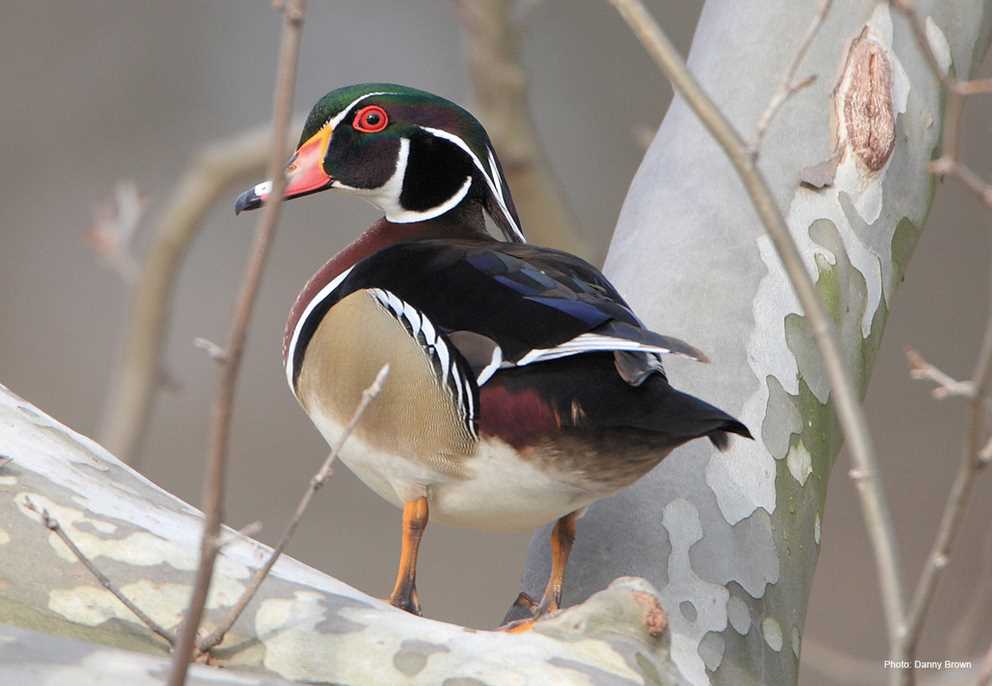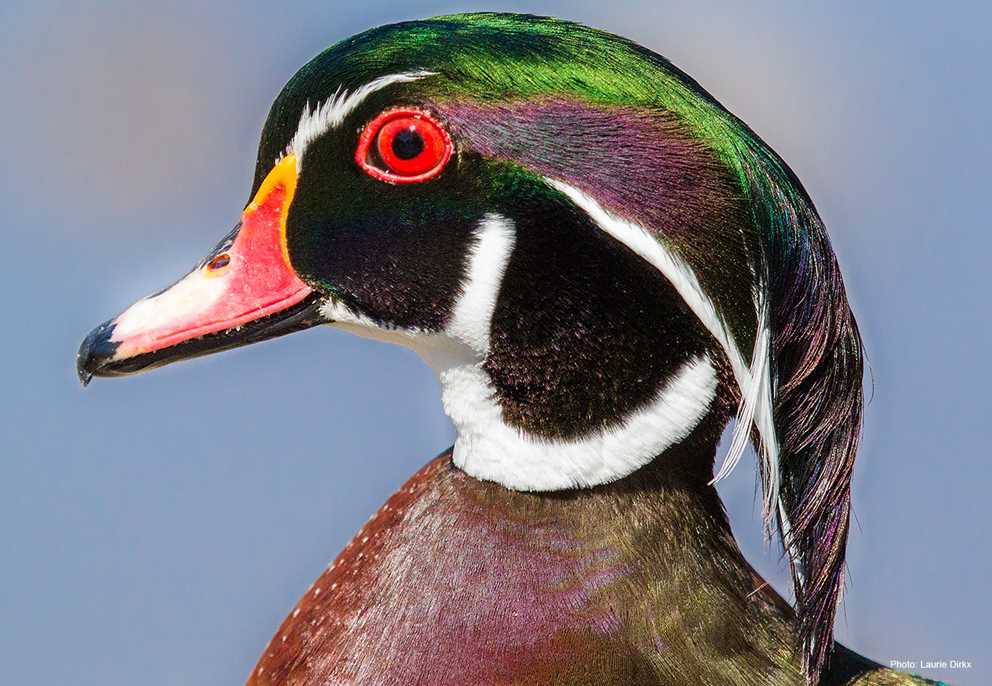Overview
Wood Ducks are common in riparian wetlands, forested swamps, and freshwater marshes. Their range is restricted to North America, with two disjunct breeding populations, one that ranges from southern British Columbia, Washington and Montana south along the west coast to California, and the other from southern Manitoba, Ontario and Quebec south across roughly the eastern half of the US to the Gulf Coast, and Cuba.
Males are easily distinguished by having an iridescent head of green, blue and purple, white lines from the top of the base of the bill, and from behind the eye, out on to the distinctive crest. The upper parts are mostly black. The throat and neck are white, while the breast is chestnut with rows of white spots, and the flanks are goldish with fine dark vermiculation, the belly is white. The base of the bill has yellow margins, becomes rosy pink then white with a dark saddle and tip. Females are olive-green to gray with subtle iridescent tones of blue-green overall with a gray-brown crest, a notable white tear drop around the eye, a white belly, and mostly grayish bill.
Nests are in cavities, usually near or over water, and they make extensive use of nest boxes in open and emergent marsh areas.
Description
Key Identification Features:
- Mid-sized ducks, with a crested head, broad wings, and a large rectangular tail.
- Males are unique, with distinctive facial pattern including an iridescent green/purple head, red eye and eye ring, two white lines on the crest, white throat with two finger like projections on the cheek, burgundy breast with white spots, and iridescent blue speculum with a trailing white edge.
- Females are olive gray or brown with subtle blue, purple and bronze iridescent, have a gray to brown crest, a notable white tear drop around the eye, and dark wings with an iridescent blue speculum and white trailing edge.
Male/Female Average Length and Weight
- Weight: Males 1.1–1.9 lbs.; Females 1–1.9 lbs.
- Wingspan: Males 8.6–9.4 in.; Females 8.3–9.1 in.
Male Identification:
- Alternate (Breeding) Plumage: Males are easily distinguished by having an iridescent head of green, blue and purple, white lines from the top of the base of the bill, and from behind the eye out on to the distinctive crest. The upper parts are mostly black with tones of iridescent green or bronze. The throat and neck are white, while the breast is chestnut with rows of white spots, and the flanks are goldish with fine dark vermiculation, the belly is white. The undertail coverts and feathers on the side of the rump are reddish-violet. The base of the bill has yellow margins, becomes rosy pink then white with a dark saddle and tip.
- Basic Plumage: Overall brownish-gray, with a white belly.
Female Identification:
- Alternate (Breeding) Plumage: Females are olive gray or brown with subtle blue, purple and bronze iridescence, have a gray to brown crest, a notable white tear drop around the eye, and dark wings with an iridescent blue speculum and white trailing edge.
- Basic Plumage: Overall brownish-gray, with a white belly.
In-Flight Identification:
- In flight, the wings appear dark, with glossy green and blue iridescence, with an iridescent blue speculum with a trailing white edge.
Vocalizations:
- Males emit a high pitched “ji-ihb” that is somewhat drawn out, that can only be heard when in close proximity.
- Females emit a loud “oo-eeek oo-eeek”, often heard when taking flight or sometimes in flight.
Similar Species:
- Hooded Merganser: May be confused with Hooded Mergansers in poor light, and because of habitat preference overlap. Wood Ducks are heavier bodied, with broad wings and tails, and lack the choppy fast wing beats in flight compared to Hooded Mergansers. Hooded Mergansers in flight show more white on the wing than Wood Ducks.
Habitat Preferences
- Breeding: Wood Ducks are typically found on freshwater forested wetlands, swamps, and emergent wetlands.
- Migration and Wintering: They use forested wetlands but may also be seen on freshwater emergent wetlands occasionally.
Foraging Habits and Diet
- Wood Ducks eat a diversity of acorns, seeds of maple, ash, elm and tupelo, seeds of a variety of aquatic plants, and a variety of aquatic invertebrates, especially insects. Wood Ducks also may be found feeding in harvested grain fields, especially corn, wheat and rice fields. They are lumped with dabblers, but the bill is particularly adapted to foraging for seeds.
Breeding Habits
- Monogamy: Wood Ducks are seasonally monogamous, and males leave with onset of incubation. The age at first breeding is one year. Wood Ducks may initiate nests as early as February in southern portions of their breeding range, but typically initiation is March to June depending on latitude. Some females have been documented to hatch two nests per year, with the frequency of second nests increasing with decreasing latitude across their breeding range.
- Nest Locations: They nest in cavities of trees and also readily use nest boxes. Females do not add material to cavity nests but do cover the eggs with down as laying progresses.
- Clutch Size: 9 to 12 eggs. Females may also lay in nests of other females, resulting in abnormally large clutch sizes sometimes over 20 or 30 eggs. The white eggs are elliptical to sub-elliptical, and are 2 by 1.5 in. The incubation period is 28 to 30 days.
Migration and Distribution
- Birds residing at southern latitudes may be considered resident and non-migratory.
- Fall Migration: Poorly documented but Wood Ducks probably depart breeding wetlands in October or November depending on latitude.
- Spring Migration: February through April with arrival on breeding areas in March to early May.
Conservation Status
- IUCN Status: Least Concern
- Population Status: Accurate population estimates are not possible because forest-dwelling birds cannot be easily and accurately surveyed. However, Wood Duck populations are stable to increasing throughout their range based on harvest and other information.
- Conservation Concerns: Degradation of forested wetlands reduces habitat and availability of nesting cavities.
- Conservation Focus: Protecting forested wetlands and increasing timber along waterways may create beneficial habitat. Installing nest boxes that are close to water and concealed in good habitat will increase the availability of nesting sites.
Harvest Information
- An average of 976,325 Wood Ducks were harvested annually across the US from 2019 to 2022.
- Wood Duck harvest is typically highest in the Mississippi Flyway, accounting for 50 to 60 percent of the total US harvest.
- Top three harvest states during the 2019 to 2022 hunting seasons were North Carolina (405,781), Wisconsin (339,101), and Minnesota (327,515).
